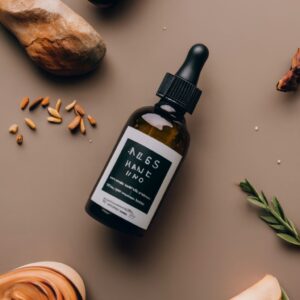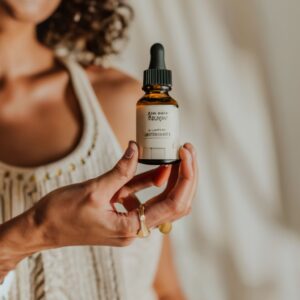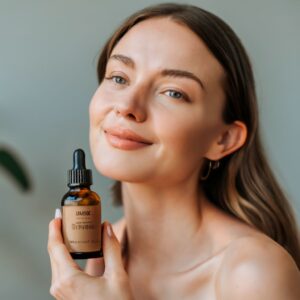
For those grappling with dry, parched skin, finding the right skincare regimen can feel like a quest for the Holy Grail. Enter face oils – these luxurious elixirs have emerged as a beacon of hope for those seeking deep hydration and nourishment. Tailored specifically for dry skin types, face oils offer a potent blend of emollients, antioxidants, and essential fatty acids, working in harmony to replenish moisture, restore suppleness, and unveil a radiant complexion. In this guide, we’ll embark on a journey through the realm of face oils for dry skin, exploring their transformative benefits and discovering how they can revitalize and rejuvenate even the most dehydrated complexion. Say goodbye to dull, lackluster skin, and prepare to embrace a radiant, dewy glow with the power of face oils.
Why Make Homemade Face Oil for Dry Skin:

Tailored Formulation:
Homemade face oils allow you to customize the ingredients to suit your specific skin needs. By selecting oils rich in moisturizing and nourishing properties, you can create a formula tailored precisely to address the concerns of dry skin.
Pure and Natural Ingredients:
Homemade face oils typically contain pure and natural ingredients, free from synthetic additives, preservatives, and fragrances. This purity ensures that you’re feeding your skin with only the best, most wholesome ingredients, minimizing the risk of irritation or adverse reactions.
Cost-Effective Solution:
Creating your own face oil at home can be a cost-effective alternative to store-bought products. Many high-quality carrier oils and essential oils are readily available at affordable prices, allowing you to indulge in luxurious skincare without breaking the bank.
Control Over Quality:
When making homemade face oil, you have complete control over the quality of ingredients used. You can source organic, cold-pressed oils known for their superior quality and potency, ensuring that your skin receives the maximum benefits of each ingredient.
Freshness and Potency:
Homemade face oils are made in small batches, ensuring freshness and potency of the ingredients. Unlike commercial products that may sit on shelves for extended periods, homemade oils are crafted with care and can deliver optimal results to your skin.
Sustainable and Eco-Friendly:
Making your own face oil at home promotes sustainability and reduces environmental impact. By using reusable containers and minimizing packaging waste, you’re taking a proactive step towards a more eco-friendly skincare routine.
Empowerment and Creativity:
Crafting homemade face oil empowers you to take charge of your skincare regimen and unleash your creativity. Experimenting with different oils, botanical extracts, and aromas allows you to personalize your skincare experience and discover what works best for your skin.
face oil for dry skin recipe

Ingredients for Face Oil for Dry Skin:
Carrier Oils:
- Sweet almond oil
- Jojoba oil
- Avocado oil
- Rosehip seed oil
Optional Essential Oils:
- Lavender essential oil
- Frankincense essential oil
- Geranium essential oil
- Rose essential oil
Tools Used in Making Face Oil for Dry Skin:
- Glass Bottle or Dropper: Used to store and dispense the face oil blend.
- Measuring Spoons: For accurately measuring the quantities of carrier oils and essential oils.
- Funnel (optional): Helps to transfer oils into the bottle without spillage.
- Stirring Rod or Pipette: Used to mix the oils thoroughly in the bottle.
- Patch Test Area: A small area of skin (inner forearm) for performing a patch test to check for any adverse reactions before applying the face oil to the entire face.
- Clean Hands: Essential for massaging the face oil into the skin during application.
step-by-step guide for face oil for dry skin

Creating a homemade face oil for dry skin is a straightforward process that involves selecting nourishing carrier oils and optional essential oils to suit your skin’s needs. Here’s a step-by-step guide to making a simple yet effective face oil for dry skin:
Step 1: Choose Carrier Oils
- Start by selecting one or more carrier oils known for their moisturizing and nourishing properties. Some excellent options for dry skin include:
- Sweet almond oil: Rich in vitamin E and fatty acids, it deeply hydrates and softens the skin.
- Jojoba oil: Similar in composition to the skin’s natural oils, it helps balance moisture levels and supports skin barrier function.
- Avocado oil: Loaded with vitamins and antioxidants, it provides intense hydration and promotes skin elasticity.
- Rosehip seed oil: Packed with essential fatty acids and vitamins A and C, it helps repair and regenerate dry, damaged skin.
Step 2: Optional Essential Oils
- If desired, you can enhance your face oil with a few drops of essential oils known for their skin-nourishing and aromatic properties. Some suitable options for dry skin include:
- Lavender essential oil: Soothes and calms dry, irritated skin while promoting relaxation.
- Frankincense essential oil: Supports skin regeneration and reduces the appearance of fine lines and wrinkles.
- Geranium essential oil: Balances sebum production and helps improve skin texture and tone.
- Rose essential oil: Hydrates and rejuvenates the skin, imparting a subtle floral aroma.
Step 3: Prepare Your Blend
- In a clean, dry glass bottle or dropper, combine your chosen carrier oils in the desired proportions. You can start with equal parts of two or three carrier oils and adjust the ratios based on your skin’s needs.
- If using essential oils, add a few drops (typically 1-3 drops per ounce of carrier oil) to the blend. Be cautious not to use too much, as essential oils are potent and can cause irritation if used in high concentrations.
- Close the bottle tightly and shake well to ensure thorough mixing of the oils.
Step 4: Test Patch
- Before applying the face oil to your entire face, perform a patch test on a small area of skin to check for any adverse reactions or sensitivities. Apply a small amount of the oil blend to the inner forearm and wait 24 hours to observe any signs of irritation.
Step 5: Application
- Once you’ve confirmed that the oil blend is suitable for your skin, it’s time to incorporate it into your skincare routine. Start with a clean, dry face and apply a few drops of the oil to your fingertips.
- Gently massage the oil into your skin using upward, circular motions, focusing on areas prone to dryness or dehydration.
- Allow the oil to absorb fully into the skin before applying any additional skincare products or makeup.
Step 6: Storage
- Store your homemade face oil in a cool, dark place away from direct sunlight to preserve its freshness and potency. Use within 6-12 months for optimal results, as natural oils can oxidize over time.
That’s it! With just a few simple steps, you can create a luxurious face oil tailored to nourish and hydrate dry skin, leaving it soft, supple, and glowing with health. Adjust the ingredients and proportions as needed to customize the blend to your skin’s unique needs and preferences.
Benefits of Using Homemade Face Oil for Dry Skin:

- Deep Hydration: The combination of nourishing carrier oils penetrates deeply into the skin, providing long-lasting hydration to combat dryness and dehydration.
- Nourishment: Rich in vitamins, antioxidants, and essential fatty acids, the oils replenish the skin’s moisture barrier and nourish it from within, promoting overall skin health.
- Softens and Smoothens: Regular use of face oil helps soften and smoothen the skin’s texture, reducing the appearance of dry patches and roughness.
- Improved Skin Elasticity: The hydrating properties of the oils help improve skin elasticity, resulting in a more youthful and plump appearance.
- Reduces Irritation and Inflammation: Some carrier oils, such as jojoba and avocado oil, have anti-inflammatory properties that help soothe irritation and calm redness, making them ideal for sensitive and dry skin types.
- Anti-Aging Benefits: Certain carrier oils, such as rosehip seed oil and avocado oil, are rich in antioxidants that help combat free radical damage and signs of aging, such as fine lines and wrinkles.
- Balances Sebum Production: Contrary to popular belief, using face oil can help regulate sebum production in the skin, preventing excess oiliness without stripping away natural moisture.
- Enhances Radiance: Regular application of face oil imparts a healthy glow to the skin, leaving it looking radiant and luminous.
- Customizable: By selecting specific carrier oils and essential oils, you can tailor the face oil to address your unique skincare concerns and preferences.
- Relaxation and Aromatherapy Benefits: Many essential oils used in face oil blends have aromatherapeutic properties that promote relaxation and stress relief, enhancing the overall skincare experience.
Different Ways to Use Face Oil for Dry Skin:

- Daily Moisturizer: After cleansing and toning your skin, apply a few drops of the face oil to your fingertips and gently massage it into your face and neck. Use morning and night as the final step in your skincare routine to lock in moisture and nourish the skin.
- Booster for Moisturizer: Add a drop or two of face oil to your regular moisturizer to boost its hydrating and nourishing properties. Mix well and apply as usual for enhanced moisture retention and added benefits.
- Facial Massage: Treat yourself to a luxurious facial massage using the face oil. Warm a few drops between your palms and gently massage it into your skin using upward, circular motions. This helps improve circulation, relax facial muscles, and enhance absorption of the oil.
- Overnight Treatment: For intense hydration and repair, apply a generous amount of face oil to your face and neck before bedtime. Allow the oil to work its magic overnight, replenishing moisture and rejuvenating the skin while you sleep.
- Makeup Primer: Use a small amount of face oil as a natural makeup primer to create a smooth canvas for foundation and other makeup products. It helps makeup glide on more smoothly and adds a subtle glow to the skin.
- Spot Treatment: Apply a drop of face oil directly to dry patches or areas of irritation for targeted hydration and soothing relief. This can help alleviate dryness, redness, and inflammation in specific areas of the face.
- Facial Mask Booster: Mix a few drops of face oil into your favorite hydrating face mask to enhance its moisturizing properties. Apply the mask as usual and leave it on for the recommended time to deeply nourish and hydrate the skin.
- Cuticle Oil: Extend the benefits of face oil to your nails and cuticles by massaging a small amount onto the nails and surrounding skin. This helps hydrate and soften dry cuticles while promoting healthy nail growth.
- Body Moisturizer: Don’t limit the use of face oil to just your face – it can also be used to moisturize dry areas of the body, such as elbows, knees, and heels. Apply a few drops to damp skin after showering to seal in moisture and keep skin soft and supple.
- Hair Treatment: For dry, frizzy hair, apply a small amount of face oil to the ends of damp hair to tame flyaways and add shine. You can also use it as a pre-shampoo treatment by applying it to dry hair before shampooing to nourish and condition the hair.
These are just a few of the many ways you can incorporate homemade face oil into your skincare and beauty routine. Feel free to experiment and discover what works best for your skin and hair needs.
FAQ’S
Q: Can I use face oil if I have oily or combination skin? A: Yes, face oils can benefit all skin types, including oily and combination skin. Opt for lighter oils like jojoba or grapeseed oil and use sparingly to avoid excess oiliness.
Q: How often should I use face oil? A: You can use face oil daily as part of your skincare routine, both morning and night. Adjust the frequency based on your skin’s needs and how it responds to the oil.
Q: Will using face oil make my skin more oily? A: When used in moderation and with the right oils, face oil can actually help balance oil production and prevent excess oiliness. Choose non-comedogenic oils and apply a small amount to avoid greasiness.
Q: Can face oil replace my moisturizer? A: Face oil can be used as a moisturizer, especially for dry skin, but it may not provide enough hydration on its own for some individuals. It’s best to layer it over a water-based moisturizer for maximum hydration.
Q: Can I use face oil under makeup? A: Yes, you can use face oil as a primer under makeup to create a smooth, hydrated base. Allow the oil to absorb fully into the skin before applying makeup for best results.
Q: How long does it take to see results from using face oil? A: You may notice immediate benefits like softer, smoother skin after using face oil, but long-term results may take several weeks to become noticeable. Consistent use is key for seeing improvements in hydration and overall skin health.
Q: Can I use face oil on sensitive skin? A: Yes, many face oils are suitable for sensitive skin, but it’s essential to patch test first to check for any adverse reactions. Look for gentle, non-irritating oils like jojoba or rosehip seed oil.
Q: How do I store homemade face oil? A: Store homemade face oil in a cool, dark place away from direct sunlight to preserve its freshness and potency. Use a dark glass bottle with a tight-fitting lid to minimize oxidation.
Q: Can I use essential oils in face oil for dry skin? A: Yes, you can add a few drops of essential oils to your face oil blend for added benefits and a pleasant aroma. However, be cautious not to use too much, as essential oils can be potent and may cause irritation in some individuals.
Q: Can face oil be used on other parts of the body? A: Yes, face oil can be used on other dry areas of the body, such as elbows, knees, and cuticles, to provide hydration and nourishment. Apply a few drops and massage into the skin as needed
